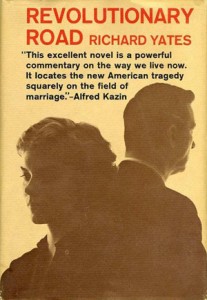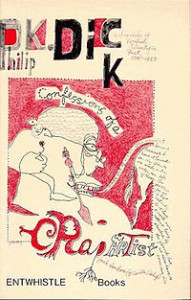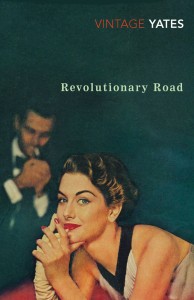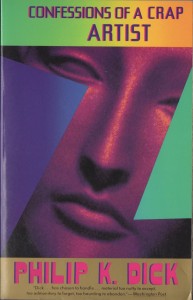
Revolutionary Road
Richard Yates
Original edition: Little, Brown, 1961
Most recent edition: Vintage, 2011
Confessions of a Crap Artist
Philip K. Dick
Original edition: Entwhistle Books, 1975
Most recent edition: Vintage, 1992
Much of Philip K. Dick’s posthumous fame comes from his novels and stories being thoroughly mined for adaptation into big budget, mega-FX films (although being championed by Jonathan Lethem and enshrined in The Library of America hasn’t hurt, either). However, I think I am on fairly safe ground in predicting that Confessions of a Crap Artist is one Philip K. Dick novel which will never be adapted for the big screen. Not that it doesn’t deserve to be. If Revolutionary Road could provide a useful platform for Kate Winslet and Leonardo DiCaprio to light up the big screen with recreations of Eisenhower Era marital conflict, then Confessions of a Crap Artist, with its even more lurid and violent depictions of discord between husband, wife, and lover from the same time period, could conceivably offer even more dramatic inspiration for the right director and actors.

However, I can just imagine would-be producers, having glanced over Confessions of a Crap Artist, bellowing at the unfortunate assistant who gave them the novel: “What the hell is THIS? Where are the mind-readers, the mutants, the Martians? How can I work any CGI effects into this? It takes place in suburbia, for Christ’s sake! Not future suburbia — nineteen-fifties suburbia! Jesus Christ, there’s not even an android or robot in this piece of shit! I can’t believe Phil K. Dick wrote this! Are there two writers named Phil K. Dick?”
In a way, there were, although both writers inhabited the brain of the same man. Throughout much of the 1950s and into the early 1960s, Dick managed to write four novels each year – two science fiction novels and two mainstream, non-genre novels. Confessions of a Crap Artist was the only one of his mainstream novels to be published in his lifetime, appearing in 1975, sixteen years after Dick wrote it in 1959. (Other mainstream novels which were published after Dick’s death include Gather Yourselves Together, The Man Whose Teeth Were All Exactly Alike, Puttering About in a Small Land, In Milton Lumky Territory, Humpty Dumpty in Oakland, Mary and the Giant, The Broken Bubble, and Voices From the Street.)
I gravitated towards Confessions of a Crap Artist due to a misconception I had of the book. I knew it was one of Dick’s non-SF novels, but based on its title, I presumed it to be a fictionalized memoir of his early years as a writer, when he’d churned out short stories and brief novels for the science fiction magazines at the tail end of the pulp era in the 1950s, a roman a clef somewhat along the lines of Charles Bukowski’s Factotum or Post Office. That would have to be one hell of a fun book, I figured (and I may need to read Radio Free Albemuth for a rough approximation of the book I was anticipating). The book I ended up reading was of a very different sort from what I’d expected, one which seemed to have a great deal in common with one of the most highly lauded novels of the era in which Dick had composed his novel. Richard Yates’ Revolutionary Road, a finalist for the 1962 National Book Award, and Dick’s Confessions of a Crap Artist were likely written contemporaneously. Both are biting portrayals of 1950s American suburban married life, with Dick’s book set in the Marin County suburbs of San Francisco and Yates’ novel set in suburban Connecticut. Both feature strong-willed, stay-at-home wives with children who chafe against the limitations of their stations in life and who yearn (and plot) for a different existence. Both focus on oftentimes savage marital combat and extramarital affairs. Both feature climaxes that result in the death of one of their protagonists. One was immediately recognized as a contemporary classic of American literature; the other struggled for publication, and appeared to little acclaim. I decided I would read Yates’ book as soon as I finished reading the Dick novel, so that I would have one fresh in my mind while reading the other. I was curious: how would Dick’s unsung work stack up, at least in my estimation, to Yates’ highly praised classic?
Even though I read the Yates book second, in this essay I’ll consider it first. It is part of the canon of postwar American literature, and thus should be thought of as the sun, the central novel of 1950s suburban marital dissatisfaction, generating the light in which the smaller, less significant satellite of Dick’s novel can be usefully viewed. In summary, it is the story of April and Frank Wheeler, a young couple who romanced and married in Manhattan in the mid-1950s and then moved out to suburban Connecticut after they had two children, only to discover a yawning gap between their dreams of personal fulfillment and the realities of their mundane, workaday lives. Rather than adjusting themselves to their new limitations and responsibilities, they ceaselessly chafe against Frank’s commuter job as an advertising copywriter at Knox Business Machines, their chores of maintaining their house and yard and raising their children, the lack of culture and arts in their suburban environment, and the seemingly pinched, bourgeois perspectives of their neighborhood friends and coworkers. They make plans to escape to what they view as a European paradise of culture and self-actualization. Much of the impetus for the planning, however, comes from April, as Frank soon begins developing cold feet at the thought of relocating his family to another continent and allowing his wife to support him while he finds himself. When a series of events causes their plans to go off the rails, rather than regroup and reevaluate, they turn on each other, and their escalating conflict leads to tragedy.
Although much of the book is told from Frank’s perspective, the real heart of the book, its most vivid and compelling character, is April Wheeler. Critical reactions to April Wheeler run the gamut. At one extreme, at least one critic I’ve come across has referred to her as the greatest monster in American literature. Readers and critics at the opposite end of the reactive spectrum regard her as a tragic heroine, a proto-Second Wave Feminist who refuses to bow down to the idols of male centeredness and traditional gender role conformity, instead sacrificing her life for her ideals. Then there are those who fall somewhere in the middle, looking at April as a very flawed but very fully realized and thus sympathetic character, a personage whose dilemma is not easily scoffed at or dismissed. Her creator, Richard Yates, has been quoted to the effect that he believed her to be a heroine. Yates’ biographer, Blake Bailey, in A Tragic Honesty: The Life and Work of Richard Yates, describes Yates’ mother as a “monster of egotism,” so self-involved that she emotionally neglected her son. So it makes a certain kind of sense that Yates could write of a mother who seemingly invests very little of herself in her children and who ultimately abandons them in a doomed quest for autonomy, yet view her as a heroine. He must have experienced vastly conflicting emotions about his own mother and her parenting.
What was my reaction to April Wheeler? Here, in the interest of full disclosure, I must reveal a telling personal detail: I was once married to April Wheeler. Yates, without ever having met my first wife, shared with me an incisive portrayal of a woman stunningly similar in many respects to the woman I initially married. Without a doubt, this colored my reaction to April Wheeler. Would I agree with that reviewer who considered April “the greatest monster in American literature?” (I wish I could find that review again so I could cite it.) No; I think that overstates matters. However, I did find April to be selfish, narcissistic, overly self-involved, all too willing to blame those around her for faults which lay within herself, and grossly neglectful towards her responsibilities as a parent. Both she and Frank, although born too early to be Baby Boomers, are predecessors of the Me Generation of the 1970s, pithily described by essayist Walter Russell Mead in an article called “Listen Up, Boomers: the Backlash has Begun.” Frank is portrayed as being a somewhat more responsive and sensitive parent than his wife, but the difference between them in this regard is one of degree, not kind. Yet, so skillful is Yates in his psychological portraiture that, even given my predisposition to resent and dislike April Wheeler, I still ended up occasionally sympathizing with her; and, even following her final, self-destructive act, which left her children bereft of a mother, I did not hate her, only pitied her.
Apart from April Wheeler, how did I feel about other aspects of Yates’ novel? That’s a bit like asking, “Apart from that momentary unpleasantness, Mrs. Lincoln, how did you like the play?” I certainly admired Yates’ plot construction. He maintained a tone of anxiety and mounting dread all the way through, very skillfully deploying a series of plot developments to continually tighten the screws on the Wheelers and make their plans for escape and renewal more and more unworkable. He was very good at evoking the humanity and uniqueness of his minor, supporting characters, with one exception (which isn’t really his fault) avoiding easy, stereotypical portrayals. The one minor character who tended to grate upon me was John Givings, the mentally ill adult son of the Wheelers’ Realtor; he is used in the book as a sort of Holy Fool, his mental illness giving him license to say aloud the truths no one else is willing to voice. My problem with John Givings is that, since the time Revolutionary Road was published, the mentally ill as Holy Fool has become a stereotypical trope, given much impetus by the book and film versions of Ken Kesey’s One Flew Over the Cuckoo’s Nest. Yet this can’t be held against Yates. To the author’s great credit, he does not portray Frank’s bosses at Knox Business Machines as soulless ogres or greedy, grasping philistines, which would have been the easy, obvious play; he allows them to express their sales-centered, capitalist philosophy with dignity and earnestness, so much so that they make at least a partial convert of Frank.
To me, however, the real hero of the novel, if there can be said to be one at all, is Shep Campbell. Shep and his wife are supposedly the Wheelers’ best friends, but both Frank and April denigrate them behind their backs for their lack of sophistication. Shep is secretly in love with April. Near the story’s end, admitting to herself that she has never truly loved her husband, April allows herself a meaningless one night stand with Shep in the back of Shep’s car. Despite this moral lapse, Shep approaches heroism near the book’s end when, realizing his wife’s intellectual and emotional limitations, he recommits himself to life with her because of her steadfast loyalty and their mutual need to maintain their family unit. Frank is spiritually and emotionally destroyed by the book’s events, but Shep, who had been continually looked down upon by the Wheelers, manages to arrive at a kind of wisdom which will allow him to live his life with a measure of satisfaction.
In Confessions of a Crap Artist, the direct analogues to April and Frank Wheeler are Fay and Charley Hume. Fay and Charley aren’t the book’s true protagonists, however. This is a good thing, because compared to the Wheelers, they are flat, almost cartoonish characters. Fay is a manipulative Black Widow or Dragon Lady, and Charley is a stereotypical put-upon husband, whose emotions and reactions are ramped up to parodic heights of vitriol and violence. A standout example of the marital dynamic between them comes when Fay decides to torment her husband by sending him on an errand to the drugstore to buy tampons. Rather than refuse, he spends half his day working up the nerve to bring a box of tampons to the cash register; when he gets home, he repays Fay for his humiliation by beating her. From this bare synopsis, the portions of the book that focus on Fay and Charley sound stomach-turning. Yet Philip K. Dick was a surprisingly funny writer, a quality of his which does not come across at all in the filmed adaptations of his work. Confessions of a Crap Artist is a satire, an often blackly amusing satire, and Fay and Charley are its two main clowns, the novel’s version of Punch and Judy. The “crap artist” of the title is Fay’s brother, Jack Isidore, a man who nowadays would probably be diagnosed with a mild version of Asberger’s Syndrome. Charley dubs Jack a “crap artist” because of Jack’s tendency to collect large quantities of odd abandoned objects, like certain bottle caps and sea shells, as well as science fiction pulp magazines, and due to the credulity with which he accepts various crackpot theories advanced by the pulps, such as UFOs, Fortean phenomena, the hollow Earth of Shaver’s mysteries, and psionics. After Jack is forced out of his apartment, his sister sends her husband to collect him and bring him out to live with them and their children in the rural suburbs of Marin County outside San Francisco. A good deal of the the novel’s satirical bite comes from the interplay between Jack and Fay and Charley; the latter two consider Jack to be hopelessly maladjusted and just plain weird, yet in many ways (such as his ability to interact in a healthy manner with the couple’s two young daughters, in contrast to the attenuated parenting they receive from their mother and father), Jack proves to be far more “sane” and well adjusted than his upper middle class, materially successful hosts. Jack plays somewhat the same role that John Givings plays in Revolutionary Road, but, being a more well rounded and fully developed character than John, he does not come off as a stereotypical Holy Fool. If I can be said to have had a disappointment with the book, it would be that Jack doesn’t receive enough “page time.” Despite being the novel’s titular character, only about a quarter of the book is told from his vantage point; the other three quarters are told from the viewpoints of either Fay, Charley, or Nat Anteil, the graduate student who is attracted into Fay’s romantic web. Nat is the other character whom I would describe as a protagonist. In personality, he is somewhat similar to Frank Wheeler; he sees himself as an intellectual, someone culturally superior to the suburban burghers and matrons who surround him. Yet, for all his intellect and considerable insight, the most salient aspect of his character is his passivity. He allows Fay to pull him away from his young wife, Gwen, into an illicit affair, recognizing and even admiring Fay’s skillful machinations as they progress, and making very little effort to oppose them. After a minimal struggle, he resigns himself to an existence as Fay’s factotum and youthful lover, rationalizing his surrender by paying homage to her strength of will and to the material comforts (originally provided by the doomed Charley’s labors) that his surrender will access for him.
Is Revolutionary Road the superior work? I would judge the answer to be yes, due to Yates’ more finely crafted prose and his overall richer level of characterization (of the Wheelers in particular, yet nearly all of his minor characters are also very three dimensional and compelling in their own right). Revolutionary Road is a much longer book than Confessions of a Crap Artist, easily twice as long; such rich characterizations require a goodly number of words. Yet Confessions of a Crap Artist, being intended as a satire, benefits from its compactness. Despite the book’s relative brevity, Dick managed to offer his readers two fully realized characters, Jack Isidore and Nat Anteil, who in their own way are as compelling as most of the characters in Revolutionary Road. Also, although Dick’s prose is much more workmanlike and plain than Yates’, he provides some memorable portraits of suburban Marin County in the 1950s, the small town main streets, the farms, and the rugged beaches. Although it does not attain quite the same stature as Revolutionary Road, Confessions of a Crap Artist has pleasures all its own. It can be enjoyed as a companion piece to Revolutionary Road, and it can be fully enjoyed on its own merits. It is fascinating to witness how Yates and Dick, living on opposite coasts and considered to be vastly different sorts of writers during their careers, were mining essentially the same dramatic materials at the same time. Considering that it was written during a period when Dick was pounding out four novels a year, Confessions of a Crap Artist was likely composed in one eighth (or less) the time that Yates devoted to writing Revolutionary Road. It makes one wonder what sort of literary monument Dick could have constructed had circumstances allowed him to devote two or three years to working on a single book, rather than pushing the novels out as fast as his fingers could roll sheets of paper into his typewriter.



” However, I think I am on fairly safe ground in predicting that Confessions of a Crap Artist is one Philip K. Dick novel which will never be adapted for the big screen.”
It has been adapted. See the wikipedia article.
You are correct, sir. It was a French production, released only in the French market in 1992. I didn’t come across any mention of this film (“Confessions d’un Barjo”) until after I’d written this article, when I participated in a convention discussion panel on film adaptations of Philip K. Dick works. Thanks for bringing it to my attention again.
Nice to know I’m not alone in noticing the similarities between these two. When I first discovered Revolutionary Road a decade or so ago, it reminded me a lot of Dick’s mainstream work, albeit more developed, and with a more polished prose style. Another fine novel mining similar territory, although to gentler effect, is Alison Lurie’s THE NOWHERE CITY.
Richard, thanks so much for dropping by and for leaving this insightful note. I hope you’ll come by frequently to visit.
[…] 1 / 2 / 3 / 4 / […]